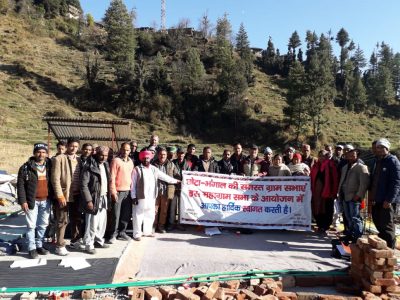Empowering Forest Communities in Chamba, Himachal Pradesh: The BIPP-ISB initiative on Forest Economy (IoFE)

The BIPP-ISB initiative on Forest Economy (IoFE) has started the process of claim filing for Community Forest Resource (CFR) rights in Chamba. The process involved various entities such as the government, volunteers, student federations, Gram Sabhas and Gram Panchayats, Forest Department and the Tribal Development Department. For a successful claim filing process forest boundary maps, existing list of forest rights holders, existing Forest Rights Committee members list, and Self Help Groups. The team first verified Forest Rights Committees, prepared forest boundary maps, and conducted training workshops. We hired human resources for coordination across Pangi in conducting workshops on IoFE and Forest Rights Act. We conducted a training workshop on claim generation for the panchayat secretaries. The Sub-Divisional Magistrate assisted us by extending the invitation to Women and Child Development workers seeking their active participation in the claim-filing process. This step enabled Sub-Divisional Level Committee (SDLC) to distribute claim filing resources, maps, RoR, and claim forms, to the FRCs through the panchayats The DC and SDM of Pangi were supportive of the initiative, and student federations and political party members were also interested in the work.
We met the District Collector (DC) of Pangi for his support, as it is vital at various levels of our work. Despite facing human resource constraints, he was keen on CFR. He extended his support by involving the SDM office of Pangi, his Additional District Magistrate (ADM), and the Resident Commissioner of Pangi in initiating the claim filing process. With their help, we collected the forest rights for 105 revenue villages of panchayat boundary maps, rivers, road shapefiles, and the bhunaksha maps from the District Revenue Officer of Pangi.
After learning about our initiative, the Student Federation of India (SFI) and CPI party members expressed interest in the work. They connected us with other volunteers enthusiastic about working for the CFR process.
The CPI party member envisioned FRA in 1987 and set up a training school with a library called Chetna Kendra. We met the Chetna Kendra students, and a few volunteered to work in the initiative of IoFE. The SFI president was keen to be a part of IoFE work and helped us get in touch with a few students (girls) interested in volunteering.
In our meeting with the Superintendent Forest Department, we gathered collection permits, export permits, and details of the local traders of Seasonal Forest Products (SFP) such as Kuth, Ban Lahsun, Parish, and others. Hazelnuts and walnuts are currently not being traded, and we plan to start the process in the future.
The Patwaris, Naib Tehsildar, and ISB team worked together to accurately map the boundaries of the forest using local methods, with the help of the Forest Department. They demarcated private lands in unoccupied revenue villages and forest lands in inhabited ones. They first separated the naksha haq bartan (NHB, forest rights) among the patwaris, who filled in the khasra numbers (plot numbers) against each revenue village and total area. This was compared to the rights held by the communities. The team referenced both the kharsa numbers listed in the NHB and the latest jamabandhi (revenue documents) to verify the ownership of each piece of land. Despite the challenge of matching the mid-20th century record of the NHB with the latest ownership records, the task was successfully completed with great effort and on time.
We met the SDM for his assistance in collecting the FRC’s Pangi voters list from the BDO office, through whom the claim filing documents, such as claim forms, forest rights holders list, forest boundary maps, and voter list, will be sent in the capacity of chair SDLC. The Area Research Office of the Tribal Development Department helped the Sub-Divisional Magistrate and Sub-Divisional Level Committee.
We faced challenges with the names of forests as clear information about inhabited and uninhabited revenue villages was unavailable, the exact access of forest by villages was unclear, and names and spellings were different on different maps. We sought help from the Forest Department by matching the list of forests from the Forest Department with the Forest Rights Committees. The SRLM team consisting of the Area Coordinator, MIS assistant, coordinating officer, and Revenue Department, also supported the IoFE initiative in constituting 1000 SHGs in Pangi with the help of CRPs.
Due to the human resource crunch, we hired people to help fasten the process of claim filing and boundary mapping. We also mobilized SHGs for the sample sale of Hazelnuts and Walnuts. The DFO helped in providing the Forest Department’s Records of Rights.
Ms. Apurva Duddu and Ms. Yamini from IoFE conducted an Anganwadi meeting for community mobilization with the RC office to discuss setting up SHGs, VO, and CLF for the enterprise model. The RC, SRLM, and the CDPO were instrumental in involving the Anganwadi workers, who were essential for the claim filing process. The meeting was attended by Anganwadi workers, PRI, panchayats leadership, BDC member, SDLC member, Resident commissioner, and ARO, Range and Beat officers from the forest department. They expressed interest in our enterprise model and the SHGs. Knowing how it would help them, they vouched to fulfil their roles and responsibilities to make it happen.
The BIPP-ISB team of IoFE, Mr. Satya Prasanna and Ms. Apurva Duddu conducted workshops with FRCs and PRIs for orientation in the forest rights act and claim filing process.
A joint physical verification process was conducted in the 53 Gram Sabhas with ample women participants to ensure the process moves in the right direction.
We are collecting the forest rights records for all blocks of Chamba and look forward to completing the task successfully, as we did in Pangi.



